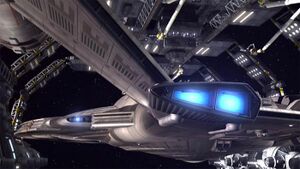Impulse Engines
The impulse engines are propulsion systems used for sublight speeds. In Federation starships, the impulse drive is essentially an augmented fusion rocket, usually consisting of a fusion reactor, an accelerator-generator, a driver coil assembly and a vectored thrust nozzle to direct the plasma exhaust. The fusion reaction generates a highly energized plasma. This plasma, ("electro-plasma") can be employed for propulsion, or can be diverted through the EPS to the power transfer grid, via EPS conduits, so as to supply other systems. The accelerated plasma is passed through the driver coils, thereby generating a subspace field which improves the propulsive effect.
In 2267, Science officer Spock calculated the explosive force of an overloaded Starship-class impulse engine to be 97.835 megatons. (TOS: "The Doomsday Machine")
By the 2270s, impulse was capable of sustaining Warp .8 without the warp drive even being online. (Star Trek: The Motion Picture)
The impulse drive of Bajoran interceptors cannot operate within an atmosphere. (DS9: "The Siege")

Background[edit]
Dialogue from several episodes, including "Where No Man Has Gone Before", and "The Doomsday Machine" suggests that the impulse drive could be used in some manner to propel a ship at faster than light speeds, albeit with a lower maximum speed and a higher rate of fuel consumption than the main warp drive.
In The Motion Picture, The Enterprise traveled at Warp .5 from Earth to past the planet Jupiter, a distance of (at a minimum) 390,674,900 miles in 1.8 hours, making that speed approximately equal to 97,026 kilometers per second (217,041,611 miles per hour), or roughly 1/3 light speed. The difference may be explained by differences in orbital precession between the two planets at the time, or, as with warp drive, there may be other variables involved.
According to Jo'Bril in the episode "Suspicions", the shuttles aboard the Enterprise-D had a maximum impulse velocity of approximately 2.5% of light speed – he specified that at 3/4 impulse the shuttle would travel a distance of 1,000,000 kilometers in approximately 3 minutes.
A reference made in "Fair Haven" indicated that USS Voyager's impulse power would not be enough to outrun an approaching neutronic storm that was traveling at a velocity of 200,000 kilometers per second (447,387,258 miles per hour), or roughly 2/3 the speed of light.